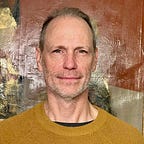Hope for a Better, Black & White America
I opened Medium yesterday for the first time in a couple of weeks. On the top of my feed was an article by Allison Gaines: Here Are The 5 Types of White People You Meet in America. Poised so high on the podium, a lot of people had to be reading it, and the Medium algorithm thought it right for me.
I clicked and found compelling visuals. At the top is an image of five white people, four men, one woman, all nattily attired. The image itself is attributed to a Christian media organization called K-Love. The subtitles stand boldly: The Karen, The White Supremacist, The Denier, The Troll, The Ally.
Like everyone, I’ve written a book: American Butterfly. It is a novel informed by real world events and set in the South and the North. It is told by a White man trying to make sense of a public murder, a social tragedy, all in the hope of bridging the gulf growing among our big American family.
Slipping into the 5 Types article, I hoped to learn more about how others look at this challenging world.
I read quickly and assumed myself an Ally, of course. Unfortunately, the Ally image shows only ethereally-happy young people, bathed in the light of a multi-cultural paradise. I am no longer young physically, no matter how youthful I might think myself. And the Ally description goes on to declare that Allies can only be “appointed by Black people.”
That makes sense, I suppose. No matter the people one believes to be friends, it is presumptuous to latch onto another’s cause. We see avowed allies rejected and held at arms length in other historic rebellions, too. The English woman, Bridget Rose Dugdale, was never accepted by the IRA despite her flamboyant efforts on behalf of Irish liberation.
That means, apparently, that I may not be an Ally. And since I have no desire to be the slightly reprehensible “Self-Appointed Ally” described at the end of the article, I feared that — with no other choices — I might have to place myself somewhere else among the archetypes of White people.
I reviewed the descriptions of the avatars again to see where I might fit into this cosmology of America:
The Karen
The only female archetype on the list, The Karen is pretty straightforward. I am not a woman. I am White, though, and people may choose to view this article as a cry of complaint. So maybe some would think me a Karen…
The White Supremacist
My Southern parents were dismayed with what they viewed as my “anti-West, anti-imperialist, anti-Southern” sentiments that emerged later in life. A dedication to freedom, fairness, and equality within America and the world probably saves me from this designation. But again, I am White, and I did go to an elite Southern high school. So…
The Denier
On the face of it, I am absolutely not the denier. A third of American Butterfly discusses how the narrator was raised racist, was not taught about real Jim Crow, and how facts like the Tulsa Race Riots were completely whitewashed. And yet, I do believe that anti-bias progress has been made in American police forces since the 1960’s. And I will argue that, though I’m deeply against the systems that produce America’s inhuman incarceration rates, there remains a place for well-educated, well-supported, community policing. So…
The Troll
I have spent many months talking with people about the importance of Black Lives Matter (Too). And how, in a future, more perfect world, All Lives Matter and Blue Lives Matter might possibly be helpful. However, when such phrases are used at this critical moment in time, they undermine the fight against one of America’s worst injustices. Still, I have to admit that the (rare) looting of a retail store does not usually advance the cause of justice and equality. So…
Where does that leave me?
Broken-hearted. A little sad.
The article compartmentalizes White people into groups in much the same way I heard Black people compartmentalized when I was a child in the South. It is so easy to do, and it de-humanizes quite effectively.
I suppose, too, that I had imagined many of us on the same team, working together to build a better, fairer, more equal world.
Despite my sadness, I remain committed to fighting against excessive categorization. Fighting against the awfulness of racism, bigotry, hatred, and isolationism employed to divide people. Fighting against the misuse of terms like They and Them, Left and Right, Conservative and Progressive, Socialist and Capitalist, Black and White. To helping us all see the virtues, however small, on the other side.
One of the best lines in the piece is the statement: “The real ally will listen to the concerns of Black people without sequestering all the space in the room.”
I like that. I will gladly support Allison Gaines in her fight for “equal, fair, American democracy” in the room(s) of her choice. While I fight for “equal, fair, American democracy” in other rooms.
I suspect we can make enough room in a better America for all of us.
